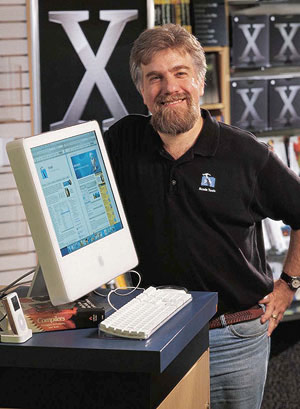
Spring 2005: 40 Years
r. r. jones
Ted Goldstein
Vice President of Development Technologies, Apple Computer
B.A. Computer and Information Sciences, Stevenson and Oakes Colleges, 1983
Ted Goldstein has built a successful career in the computer industry by combining expertise in programming with an appreciation for the human side of technological innovation. Now a vice president at Apple Computer, Goldstein oversees the development of programming tools for Apple’s highly acclaimed new operating system, Mac OS X.
In his work, Goldstein says he draws on the entire breadth of his undergraduate education at UC Santa Cruz. When asked about influential teachers, he mentions not only computer science professor Ira Pohl, but also Murray Baumgarten, professor of English and comparative literature.
“Having a liberal arts degree is terrific. I find that so much of what we do is not just about technology, but about technology in the context of people and society,” he says. “The Stevenson core course is as important in what I do as Data Structures 101, because it’s all about people.”
The programming tools Goldstein develops at Apple are used by software developers to create applications for OS X. Just as OS X is designed to be a friendly, trouble-free system for ordinary users, the developer tools are designed to make writing software for OS X easy and efficient.
“We try to design things that are good for developers as well as end users,” Goldstein says. “Everywhere I go, I meet people who love Apple products—it’s a very gratifying part of the job.”
Although Goldstein graduated from UCSC long before the Jack Baskin School of Engineering was established, he received specialized training in one of the core areas of computer science—programming languages—that helped give the campus a solid foundation on which to build its engineering school.
“When I came out of UCSC with an undergraduate degree, my training in the area of programming languages and tools was as good as or better than that of many students with graduate degrees from well-known schools,” Goldstein says.
Starting out as a consultant working for a variety of start-up companies, he ended up at the legendary Xerox Palo Alto Research Center (Xerox PARC), birthplace of such concepts as the mouse, laser printers, and the graphical user interface. When Xerox PARC spun off ParcPlace Systems to commercialize its highly influential programming language, called Smalltalk, Goldstein went along as a member of the ParcPlace management team.
From ParcPlace, he went to Sun Microsystems, where he spearheaded the development of Java Card, the leading platform for “smart cards.” More than 750 million smart cards are now used for banking, cell phones, and other purposes throughout Europe, Asia, and increasingly in the United States.
Goldstein says he first got a sense of what computer programming can do for people while working as an undergraduate in UCSC’s first computer center. Noticing a group of biology graduate students using a text editor to do painstaking genetic comparisons, he offered to write a program that would automate much of the work for them.
“It was a wonderful experience to work with the users and design a specialized tool to meet their needs,” he says.
The resulting software, used by UCSC biologists for many years, was probably the first genetic sequence alignment editor, a precursor of the powerful bioinformatics programs for which UCSC has since become famous.
—Tim Stephens
---
PDF Version
|





